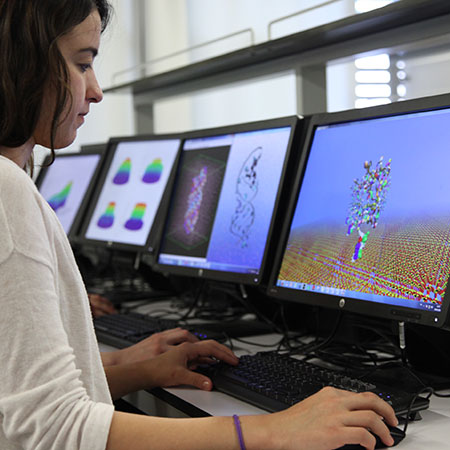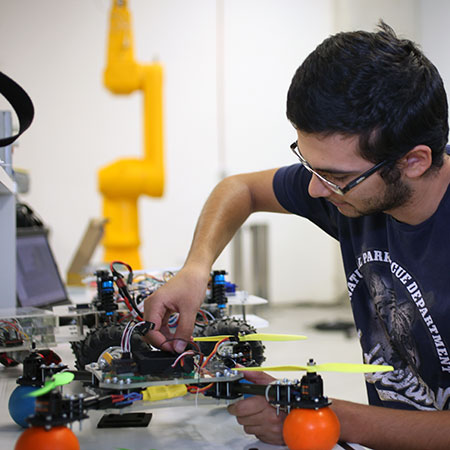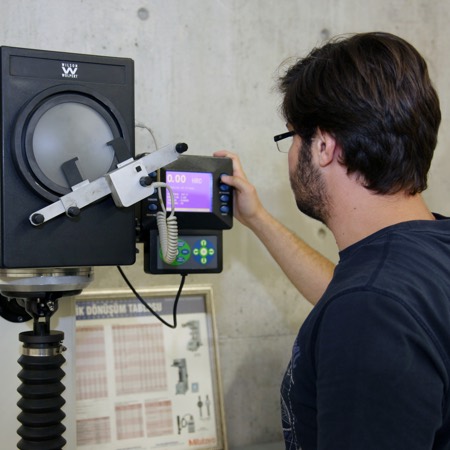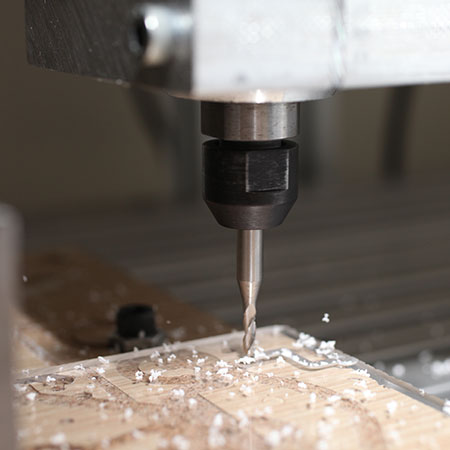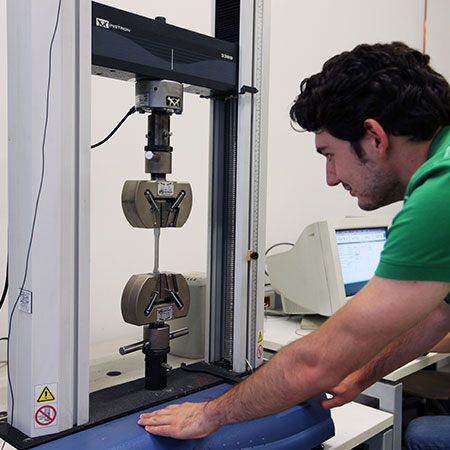| Course Code |
Course Title |
|
|
|
|
| MAK 404 |
Mechanical Design |
2 |
2 |
3 |
MAK 312 |
| Solid modeling, assembly modeling, introduction to finite element method, industrial application of finite element method, static structural analysis, thermal analysis, modal analysis, buckling analysis, free vibration analysis, harmonik analysis, dynamic analysis. |
| MAK 405 |
Reliability |
3 |
0 |
3 |
|
| Basic probability, statistics and reliability subjects applicable to mechanical systems. Probabilistic modeling of geometry, loading, stress, strength and safety factor. Reliability-based analysis and design of mechanical parts and systems. Structural reliability. |
| MAK 406 |
Experimental Stress Analysis |
3 |
0 |
3 |
MAK 206 |
| Two and three dimensional stress and strain analysis. Strain gages and strain rosettes. Strain gage networks. Photoelasticity. 2-D applications of photoelastic materials. Experimental analysis of static and dynamic problems in laboratory conditions. |
| MAK 407 |
Advanced Strength of Materials |
3 |
0 |
3 |
MAK 206 |
| Cauchy stress principle and definition of stress vector on a surface element. Stress tensor at a point in material continuum. Stress analysis of compound loading conditions. Mohr's circle in 3-D stress distribution. General elastic constitutive equations. Energy methods. Application of Castigliano's theorem to various practical problems. Elastic and inelastic deformation analysis. Yield criteria. Elastic and inelastic buckling of columns. |
| MAK 408 |
Optimization Techniques and Applications |
3 |
0 |
3 |
MAT 201 |
| Introduction and basics of optimization. Unconstrained optimization. Analytical methods, numerical methods and algorithms for unconstrained optimization. Constrained optimization. Analytical methods, numerical methods and algorithms for constrained optimization. Basics of global optimization methods, multi-objective optimization methods and response surface method. Applications. |
| MAK 410 |
Finite Element Method |
3 |
0 |
3 |
MAT 202 |
| Division of physical and spatial solution domain into finite elements. Interpolation polynomials and selection of their degrees. Expression of global polynomials in termd of global and local coordinates. Formulatşion of element characteristic matrices and vectors. Explicit approach. Coordinate transformation. Derivation of system equations by assembly of element matrices and vectors. Solution of finite element system equations. |
| MAK 412 |
Machine Elements II |
3 |
0 |
3 |
MAK 312 |
| Design, selection and analysis methods for machine elements. Permanent joints. Non-permanent joints. Tolerances and fits. Friction and lubrication. Journal bearings. Rolling element bearings. Couplings, clutches and brakes. Flexible power transmission mechanisms. |
| MAK 418 |
Computer Integrated Manufacturing |
3 |
0 |
3 |
- |
| Sensors and actuators. Prgrammable Logic Controller (PLC) and industrial automarion, Robotics and material handling, Concurrent enginnering, STEP based process planning. Cellular Manufacturing, Flexible Manufacturing Systems, Lean Manufacturing. Automatic identification systems in Manufacturing and RFID technology. |
| MAK 419 |
Mechanical Behavior of Materials |
3 |
0 |
3 |
MAK 217 |
| Elastic stress-strain relationships. Yielding criteria. Lattice defects. Dislocations. Plastic deformation mechanisms. Strengthening mechanisms in materials. Ductile and brittle fracture. Fundamentals of fracture mechanics: stress intensity factor and fracture toughness. Fatigue of engineering materials. Material behaviour at high temperatures: creep mechanisms. |
| MAK 420 |
Computer Aided Design |
3 |
0 |
3 |
MAK 112 |
| Computer graphics. Geometric modeling and databases. Curves, grid modeling, surface and solid modeling. Introduction to manufacturing. Conventional and non-conventional Manufacturing. Intorduction to design. Computer aided design development. Machinery, system and die design. Simulation and analysis by using CAD datas. Manufacturing draft generating. |
| MAK 421 |
Computer Aided Manufacturing |
3 |
0 |
3 |
MAK 420 |
| Numerical control systems. Codyfing and encoding. CAD/CAM-CNC systems integration. 3D scanning systems. Reverse engineering and rapid prototyping. Slikon moulding. Low in quantity manufacturing. Special topics on machining of complex geometries with numerically controlled machines. |
| MAK 422 |
Computer Controlled Machine Tools |
3 |
0 |
3 |
MAK 218 |
| Coordinate systems, motion control, table/tool movements and drive systems in numerically controlled machine tools. Machine tool-computer interface in numerically controlled machine tools. DNC, CNC and AC technologies in numerical control. Part programming techniques in CNC machine tools; manual programming, computer assisted programming; APT, part programming applications. |
| MAK 423 |
Plant Layout and Design |
3 |
0 |
3 |
MAK 218 |
| System, manufacturing system and plant concepts. Plant location. Plant layout and material flow. Material flow systems; AGVS, conveyors, robots. Inventory systems, AS/RS, interm stocks. Factors and methods for the selection of alternative solutions in plant design. |
| MAK 424 |
Production Planning |
3 |
0 |
3 |
- |
| Fundamentals of production planning and control; planning, control, planning levels; strategical, tactical, production management systems. Objectives of production planning and control. Integrated planning for production. Main production planning. Material requirement planning systems. Capacity planning. Job-machine tool allocation. Sequencing. Production control. |
| MAK 425 |
Tool and Die Design |
3 |
0 |
3 |
MAK 112 |
| Press, die and workpiece terminology. Cutting, piercing, bending and drawing dies. Die components and materials. Loading unloading devices. Strip and die design. Die making and operation. |
| MAK 426 |
Welding Technology |
3 |
0 |
3 |
MAK 218 |
| Metals and manufacturing methods. Welding methods and equipments. Structure and properties of metals. Temperature changes in welding. Shrinkage and distortion in welded structures. Pre- and post-annealing. Welding defects and metallurgical reasons. Welding of carbon steels. Welding of alloyed steels. Welding of different metals. Welding of aluminum and aluminum alloys. Welding of copper, nickel and titanium. Repair and maintenance welding, Underwater welding. Welding capability tests. |
| MAK 427 |
Metal Forming |
3 |
0 |
3 |
MAK 218 |
| Fundamentals of elasticity af plasticity. Flow curves of materials and mechanical properties related to plasticity. Bulk forming. Analyis of plastic forming processes: Bulk forming methods; rolling, drawing, extrusion, open and closed die forging processes. Sheet metal forming methods: Shearing, Bending and stretching processes, FEM and computer using in plastic forming of metals. |
| MAK 429 |
Metal Cutting |
3 |
0 |
3 |
MAK 218 |
| Cutting theory; basic orthogonal cutting mechanics, measurement of tool forces, plowing force, Ernst and Merchant Theory, friction, tool life and tool wear, cutting economics, cutting fluids and their effects on cutting, cutting tool temperature and calculations. Cutting force, power, machining time calculations and machining parameters (cutting velocity, feed rate, depth of cut) in turning, drilling, boring, shaping, planing, milling operations. |
| MAK 431 |
Manufacturing Processes Selection |
3 |
0 |
3 |
MAK 218 |
| Repeating all conventional and non-conventional manufacturing methods. Analysind manufacturibility and cost. Selecting suitable method. Applications on decreasing the secondary operations. Investigating the effect of material constarints on manufacturing methods. Analysing the cases that high speed manufacturing methods are advantageous. Selection criteria for the cases which dynamic factors are considered while machining. |
| MAK 432 |
Materials Selection |
3 |
0 |
3 |
MAK 217 |
| Material properties for component design.Diffusion in solids. Melting and solidification. Heat treatment of ferrous and non-ferrous materials. Corrosion and corrosion control. Materials selection in ferrous and non-ferrous materials. Case studies in materials selection.. |
| MAK 434 |
Non-destructive Testing Processes |
3 |
0 |
3 |
MAK 217 |
| Principles of Penetrant Inspection and its applicationı. Magnetic Particle Inspection principles, applications, magnetization techniques. Ultrasonic Inspection, ultrasonic waves, their properties, probs for ultrasonic inspection. Radiography, X-rays, gamma rays, their properties, inspection with X-rays and gamma rays. Infrared Inspection. Electromagnetic Inspection. |
| MAK 435 |
Ceramic Materials |
3 |
0 |
3 |
MAK 217 |
| Definition and applications of ceramic materials. Ionic and covalent bond formation. Structure and physical properties of ceramic materials. Defect types in ceramic materials. Phase equilibrium and phase diagrams. Sintering and grain growth. Mechanical and thermal properties of ceramic materials. Diffusion and electrical conductivity. |
| MAK 438 |
System Architecture and Innovation Management |
3 |
0 |
3 |
- |
| System architecture theory, complexity, ambiguity, interfaces, modularity, and commonality. Product development processes, house of quality, design structure matrix. Product platforms, integral versus modular designs and impact to supply chain. General patterns of innovation and industry cycles. Innovation strategy, survival and disruptive models. User innovation and restructuring organizations for innovation. |
| MAK 439 |
Sustainable Production and Eco-Inovation |
3 |
0 |
3 |
- |
| Biological and industrial ecosystems, metabolic analysis and industrial symbiosis. Competative sustainable manufacturing. Life Cycle Assessment(LCA), Streamlined LCA. Energy consumption reduction in Manufacturing Systems, Design for Environment and Sustainability. Recycling and Reuse, European Union WEEE directive.Carbon emissions, Trade and cap systems. |
| MAK 440 |
Design of Control Systems |
3 |
0 |
3 |
MAK 305 |
| Structure of control systems, review of basic concepts. Design specifications. Design in the time domain. Tuning of PID parameters. Optimization of time response. Root locus method. Design specifications in the time domain. Design by using Bode diagrams. Compensator design. State variables and state equations. Pole placement method. Preview and basics of advanced design methods. |
| MAK 441 |
Mechanical Vibrations |
3 |
0 |
3 |
MAK 203 |
| Basic definitions. Single degree of freedom systems: Equations of motion, undamped and damped vibrations, free and forced vibrations, response of systems to external excitations. Vibration isolation. Two degree of freedom systems: Equations of motion, coordinate transformation, principal coordinates, vibration modes. Torsional vibration. Introduction to multi-degree of freedom systems. |
| MAK 442 |
Acoustics and Noise Control |
3 |
0 |
3 |
MAK 203 |
| Wave motion, wave equation and its solutions. Acoustic intensity and acoustic impedance. Sound reflection, transmission and transmission loss. Sound perception and noise. Mechanism of hearing. Measurement of noise. Basic principles of noise control. Noise source identification, noise control at the source, at the path and at the receiver. Vibrations and noise. |
| MAK 444 |
Automotive Engineering |
3 |
0 |
3 |
- |
| Automobile components. Vehicle dynamics. Wheels and tires. Break systems and braking performance. Suspension system. Steering systems. Aerodynamic drag coefficient and its effect on vehicle performance. |
| MAK 446 |
Hydraulic and Pneumatic Systems |
3 |
0 |
3 |
MAK 311, MAK 305 |
| Basics of hydraulic and pneumatic control. Elements of hydraulic and pneumatic systems, their characteristics and fields of application. Hydraulic fluids. Pumps, their performance characteristics and selection. Hydraulic and pneumatic valves and their flow characteristics. Direction, flow and pressure control valves. Reservoirs, accumulators, actuators. Filtering. Hydraulic and pneumatic circuit design. Closed loop control. Elements of electro-hydraulic control. Pneumatic applications in automation. Fluid power control application examples. |
| MAK 448 |
Design of Mechanisms |
3 |
0 |
3 |
MAK 316 |
| Introduction to kinematic synthesis. Design of common linkage mechanisms: Grashof’s theorem, optimum transmission angle, four-bar and slider-crank mechanisms. Two, three and four position synthesis: Graphical and analytical methods, complex number modeling, applications of Freudenstein’s equation. Correlation of crank angles. Applications. |
| MAK 449 |
Modelling and Dynamics of Systems |
3 |
0 |
3 |
- |
| Modeling of physical systems. Energy ports. One-port and two-port elements. Mechanical, electrical, fluid and thermal system elements. Linear graph. Derivation of dynamic equations. Modeling of impure elements. Linearization. State variables. Expression of system equations in standard A-matrix form. Physical, canonical and phase variables. Time and frequency response. |
| MAK 450 |
Mechatronics Design |
2 |
2 |
3 |
MAK 305 |
| Mechatronics concept. Data acquisition and signal processing basics. Sensors. Actuators. Controllers. Mechatronic design principles and examples. Also, the students work in groups throughout the semester to complete a design-and-make type project. |
| MAK 470 |
Fluid Mechanics II |
3 |
0 |
3 |
MAK 311 |
| Euler and Navier-Stokes Equations. Laminar flow. Turbulent flow. Transition. Boundary layer theory and equations. External flow. Lift and drag force. Pipe flow. Compressible flow. |
| MAK 472 |
Hydraulic Power Systems |
3 |
0 |
3 |
MAK 311 |
| Power, head and efficiency. Similarity, specific velocity. Hydroelectric power plants. Pumps. Calculation, construction and characteristics of centrifugal pumps. Hydroturbines: Pelton, Francis and Kaplan turbines. State of the art of hydroturbines. Thoma number, cavitation and its effects on reaction machinery. CFD analysis and structural and thermal design of hydroturbines. |
| MAK 473 |
Unmanned Aerial Vehicle Design |
3 |
0 |
3 |
|
| Unmanned air vehicles. Overview of design process. Aircraft systems. Equations of motion. Preliminary sizing. Airfoil and geometry selection. Aerodynamics. Propulsion. Fundamentals of electrical design. Structures, materials and loads. Weight and balance. Stability and Control. Performance and flight dynamics. Autopilot design. Design trade-offs. Cost estimation. |
| MAK 475 |
Alternative Energy Resources |
3 |
0 |
3 |
MAK 201 |
| Alternative energy resources. Clean and sustainable energy resources. New and Renewable energy resources: solar energy, hydro energy, wind energy, geothermal energy, biomass energy, tidal waves, ocean waves. Osmatic energy. Nuclear energy. Hydrogen energy. Economical comparisons and environmental effects. |
| MAK 476 |
Solar Energy |
3 |
0 |
3 |
MAK 201 |
| Solar Energy. Methods of solar energy utilization. Instantaneous and daily average solar radiation on horizontal and inclined surfaces. Transmission of solar radiation through glass and plastics. Collection of solar radiation. Theory, thermal analysis, design and performance of flat plate solar collectors. Concentration collectors. Storage of solar energy. Solar energy applications. Solar electric power generation: direct conversion of solar energy to electrical energy, solar cells. Design of solar energy systems. |
| MAK 477 |
Wind Energy |
3 |
0 |
3 |
MAK 311 |
| Wind energy. Wind turbines. Atmospheric wind resource and characteristics. Wind turbine rotor aerodynamics and performance calculations. Wind turbine structural loading and dynamic analysis. Conceptual design of wind turbines. Wind turbine control. Wind turbine siting and wind farms. Electrical systems. Wind turbine noise. Economics of wind energy systems. Environmental aspects and impacts. |
| MAK 478 |
Power and Propulsion Systems I |
3 |
0 |
3 |
MAK 201 |
| Introduction to Internal Combustion Engines,Review of Thermodynamics of gases, Ideal Thermodynamic Cycles of Internal Combustion Engines, Real Cycles,Thermo-Chemistry and Fuels, In Cylinder Flow Characteristics and Fuel-Air Mixing, Combustion, Exhaust and Chemical Pollutants, Gas Turbines for Shaft Power Generation, Thermodynamics of High Speed Flow, Subsonic and Supersonic Flow, 1D Flow Through Inlet Diffuser and Propelling Nozzles Simple Brayton Cycle and Inter-Cooling, Re-Heat and Regenerative Cycles, Losses in GT cycles and Real Thermosynamic Cycles of GTs. Isentropic and Polytropic Efficiency, CC (Combustion Chamber) Pressure Losses, Radial and Axial Compressors, Stage Pressure Ratio, Velocity Triangles and Main Design Parameters, CFD & Power and Propulsion Systems. |
| MAK 479 |
Power and Propulsion Systems II |
3 |
0 |
3 |
MAK 478 |
| Introduction to Propulsion Systems, Review of Fundamentals: Basic Thermodynamic Relations and 1D Isentropic Flow Equations, Nozzle Flow, Choked Flow, Normal and Oblique Shock Equations, Turbojet and Turbofan Engine Performance Calculations, Turbojet and Turbofan Engine Performance Calculations, Introduction to Turboprop, Turboshaft and Propfan (Unducted Fan, UDF) Engines, Jet Engine Components – Inlet Diffuser and Propelling Nozzle, Jet Engine Components – Fan Compressor and Turbines, Combustion Chamber, Rayleigh and Fanno Flow, Ramjet and Scramjet Engine Performance Calculations, Rocket Engines, CFD (Computational Fluid Dynamics) & Propulsion Systems. |
| MAK 480 |
Thermal Design |
2 |
2 |
3 |
MAK 311, MAK 302 |
| System design concept, economy, optimal system. Pipe systems. Pumps, fan and power calculations, systems that involve pumps. Parallel and series pipe and pump connections. Heat exchangers. Mathematical modeling and simulation of thermal systems. Optimization techniques, thermal systems optimization. |
| MAK 485 |
Heat Exchanger Design |
2 |
2 |
3 |
MAK 302 |
| Types and properties of heat exchangers (HEX). Classification of HEX. Methods used in the analysis of HEX. Pressure drop and pumping power. Fouling in HEX. Compact heat exchangers. Applications of HEX: Condensers, evaporators, heaters, economizers and cooling towers. Regenerator types and calculations. |
| MAK 486 |
Energy Systems and Environment |
3 |
0 |
3 |
MAK 302 |
| National electrical energy production resources. Percentage production capacity of coal based power, hydro-potential, natural gas, geothermal, wind and municipal waste. Current and future aspects of national renewable energy resources. Biofuels and thermal efficiencies. Fossil fuel power plants, cogeneration, carbon dioxide emissions. Nuclear power plants and environment, types of reactors, cycles, enrichment. Fuel cell fundamentals and fuel cell cars. Power plants and water pollution. Economic assesments of power plants. |
| MAK 487 |
Nuclear Energy |
3 |
0 |
3 |
MAK 201 |
| Atomic structure. Bonding energy. Radioactive decay. Nuclear reactions. Fission, Fusion. Neutron interactions. Cross sections. Steady state thermal reactor analysis. Diffusion equation. Four-factor equation. Criticality calculations. Transient state thermal reactor analysis. Nuclear reactors and components. Fission reactors (pressurized water reactors, boiling water reactors, heavy water reactors, gas cooled reactors, fast breeder reactors, advanced fission reactors). Fusion reactors. Hybrid reactors. |
| MAK 488 |
Computational Fluid Dynamics |
3 |
0 |
3 |
MAK 311, MAK 310 |
| Classification of partial differential equations. Finite difference formulations. Hyperbolic partial differential equations. Parabolic partial differential equations. Elliptic partial differential equations. Stability analysis. Navier-Stokes equations: scalar representation of the Navier-Stokes equations, incompressible Navier-Stokes equations. Euler equations. Finite volume formulations. Grid generation: structured and unstructured grids. Coordinate transformation, Jacobian and metrics. Boundary conditions. Turbulent flows and turbulence models. |
| MAK 489 |
Heating, Ventilation and Air Conditioning |
3 |
0 |
3 |
MAK 201 |
| Heating, heat loss calculationsa, hot water and steam pipeline calculations, ventilation, refrigeration, vapor compression refrigeration cycles, psycrometry, evaporative cooling, cooling towers, air conditioning. |
| MAK 499 |
Independent Research |
1 |
4 |
3 |
* |
| Students with GPA greater than 3.00 are allowed to register. Students perform a research study under a supervising professor. A research report is submitted as an outcome of the study. |


